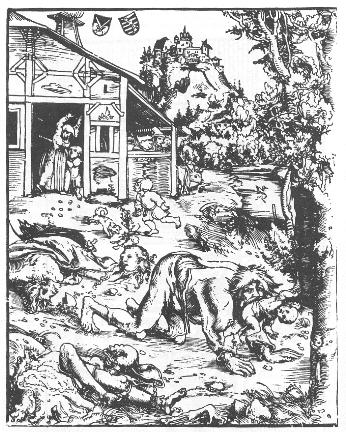Sorry for the delay in getting the next Daily Apple to you. For some reason, things have been sort of hectic since I got back from my mini-trip for the holiday, and I haven't been able to get to this.
And I've also had trouble deciding what the next entry should be about. I had a few ideas, looked into them a bit and had to discard them as too boring. So be glad I didn't take us down those paths.
Then today, on the way home from work, I heard this time-honored classic. Well, I don't know if it's either time-honored or a classic, but this song always makes me think of my brother, who thinks this is a very funny song, particularly the line, "I saw a werewolf drinking a pina colada at Trader Vicks. His hair was perfect."
So I thought, I've covered vampires, zombies, and the Loch Ness Monster, so I think now it's time to take a look at werewolves. And while you read this entry, maybe you'd like to have the above song playing in the background for your entertainment and edification.
For those of you with little children, you might not want to read this entry aloud to your young ones.

Modern-day depiction of the werewolf
(Image from Flight of the Dragon)

The Book of Were-Wolves from 1865 tells the story of Peter Stubbe who was executed in this gruesome manner, apparently to correspond with the gruesomeness of his crimes.
(Image from World's Strangest)

"Werewolf" by Lucas Cranach Sr., from around 1510, depicting the werewolf's carnage.
(Image from Duke University librarian Ed Babinski's blog)

The transformation from American Werewolf in London
(Screen shot from Saint Vespaluus)

Belladonna. This is poisonous, but at low doses, drops from the plant will make your pupils dilate. But please don't eat this. It is one of the most toxic plants in the Western Hemisphere, and though it does cause hallucinations, you get those shortly before it kills you.
(Photo from Botany Photo of the Day)

Cover of I Was A Teenage Werewolf starring Michael Landon!
(Image from Monsterland Toys)

Monk's hood or wolf's bane. This variety is pink. Others may be purple or yellow. But they're all very toxic, and you should wash your hands if you so much as touch this.
(Photo from Paghat)
I think the lesson here is to stay away from those poisonous plants.
Sources
Sk. Nur-Ul-Alam, Werewolves: The Myths and the Truths
Monstrous.com, Vampires and Werewolves
ExecutedToday.com, 1589: Peter Stubbe, Sybil Stubbe and Katharina Trump
Tracy V. Wilson, Howstuffworks, How Werewolves Work
Werewolf Info
And I've also had trouble deciding what the next entry should be about. I had a few ideas, looked into them a bit and had to discard them as too boring. So be glad I didn't take us down those paths.
Then today, on the way home from work, I heard this time-honored classic. Well, I don't know if it's either time-honored or a classic, but this song always makes me think of my brother, who thinks this is a very funny song, particularly the line, "I saw a werewolf drinking a pina colada at Trader Vicks. His hair was perfect."
So I thought, I've covered vampires, zombies, and the Loch Ness Monster, so I think now it's time to take a look at werewolves. And while you read this entry, maybe you'd like to have the above song playing in the background for your entertainment and edification.
For those of you with little children, you might not want to read this entry aloud to your young ones.

Modern-day depiction of the werewolf
(Image from Flight of the Dragon)
- The word werewolf is a combination of Anglo-Saxon words wer which means "man" and wolf, whose meaning I think you already know.
- Another term which some people in the psychiatric professions actually use is Lycanthropy. This one comes from the Greek words lukos + anthropos or "wolf man." So it means the same thing as werewolf, but it sounds more erudite, apparently.
- The first recorded mention of a werewolf was in Germany, in village called Bedburg near Cologne, in 1591.
- Wolves were plaguing the countryside and they were either attacking people (which is actually an extremely rare thing for wolves to do) or else people were afraid that the wolves would progress from attacking their livestock to attacking people.
- Then one day the townspeople had cornered a wolf and were going at it with sharp sticks and other implements. But this particular wolf, instead of lashing out with its teeth or running away, stood up and revealed itself to be a middle-aged man named Peter Stubbe who lived in the same village.
- Peter Stubbe apparently had become a very bad man. He was put on the torture wheel and said that he had killed 16 people, 13 of them children. He said he had learned sorcery when he was a teenager and had made a pact with the devil, who gave him a magic belt that allowed him to take on the guise of a wolf to attack people. As a wolf, he would bite his victim's throat and suck the blood from their veins (vampire-like, no?). If his victim were a woman, he would rape her before he killed her.
- The village decided to put Peter Stubbe to death in the most horrific way they could imagine: they pulled off his flesh with red-hot pincers, broke his arms and legs, cut off his head, and burned his corpse.

The Book of Were-Wolves from 1865 tells the story of Peter Stubbe who was executed in this gruesome manner, apparently to correspond with the gruesomeness of his crimes.
(Image from World's Strangest)
- People equated his savagery with that of wolves, and they decided that he and anybody else who committed such horrific acts were sort of channeling the savage spirit of the wolf. So I'm thinking that the story about the wolf revealing itself to be Peter Stubbe was told after the fact, and was the town's way to try to explain how somebody could do such terrible things.
"Werewolf" by Lucas Cranach Sr., from around 1510, depicting the werewolf's carnage.
(Image from Duke University librarian Ed Babinski's blog)
- After that, and throughout much of Europe, there were lots of stories about werewolves -- people who were transformed into part-wolves and attacking other people. One of the key features of the werewolf stories is the transformation process.
- Some people said that you could fall asleep and the devil would take the form of a wolf and go out and do all the things that were your worst, most evil sleeping desires and kill men and beasts.
- Other people said you could become a werewolf if a witch or a sorcerer had cursed you. Becoming a werewolf in this fashion was also an involuntary thing, and you were under the spell of someone more evil than you.
- Of course there is the now more commonly known method of becoming a werewolf, which is by being bitten. If the saliva of a werewolf got into your bloodstream, then you also became a werewolf whether you wanted to be one or not.

The transformation from American Werewolf in London
(Screen shot from Saint Vespaluus)
- But there were other stories about people who chose to become werewolves. One version of the voluntary werewolf was that evil people put on a wolf skin and went about doing terrible things while wearing the hide of a wolf. Sometimes the only bit of a wolf that the evil person would wear was a belt.
- Or a person could become a werewolf by worshiping the devil. Usually there was a ritual that involved drawing a circle on the ground and rubbing an ointment into the skin (this ointment may have contained belladonna or nightshade, which are hallucinogens in small doses). Following the ritual to the devil, you would then be given the power to become wolf-like and go do your evil things.
- There are also lots of other medical-based theories to explain the notions of werewolf-like behavior.
- One possibility is that the were-person maybe had rabies. This one is easiest to connect with the werewolf-by-biting method because rabies is often transmitted by animal bites. However, while rabies does make people writhe around and do lots of strange things, but mainly it constricts the throat and keeps you from being able to swallow and you die from it within a few days.
- It's also possible that people actually ingested something that altered their behavior. The Ergot fungus (today's generally-accepted explanation for all the insanity surrounding the Salem witch trials) which affects rye grasses is one of those possible somethings. Back in the day, people ate rye bread without realizing the rye grass had the fungus in it, and the fungus gave them convulsions and delusions and hallucinations and all sorts of unpleasant things. The Ergot fungus, by the way, is sometimes called Wolfzahn or wolf's tooth. But the Ergot fungus is more often poisonous before its hallucinogenic effects can occur. And there were far more people tried for being werewolves than there were actual outbreaks of the Ergot fungus.
- Another something that people could have eaten or come in contact with is belladonna or nightshade. These are plants which, in high enough doses, can be fatal, but in small doses can be hallucinogenic. Those ointments that people rubbed on themselves during werewolf rituals seem to may have included either one of these hallucinogens, so it's possible that the influence of a small amount of this plant is what made people go berserk.

Belladonna. This is poisonous, but at low doses, drops from the plant will make your pupils dilate. But please don't eat this. It is one of the most toxic plants in the Western Hemisphere, and though it does cause hallucinations, you get those shortly before it kills you.
(Photo from Botany Photo of the Day)
- There is also a disease which is popularly called "Wolfitis," or Hypertrichosis. Basically all that happens is you get a lot of body hair, sometimes all over the place, or sometimes localized in one or two places. But it doesn't really affect your behavior in any way.
- Or perhaps the were-people really had Porphyria. This is actually a group of diseases caused by a rare genetic disorder that makes people extremely sensitive to light, and it also affects the red blood cells so that you become very pale, and you also happen to grow a lot of body hair. While all this physical stuff is happening, you also become afflicted with various mental disturbances ranging from depression to hysteria and delirium. Late stages of this illness include a deterioration of the skin and the teeth. That all sounds really awful. This theory has also been proposed as an explanation for vampires.
- There is also a mental disorder called Lycanthropy. This is a severe form of psychosis in which the person believes him or herself to be a wild animal, usually a wolf. Nebuchadnezzar in the Bible, for example, is described to have such severe depression over a seven-year period that for a time he believed himself to be a wolf. The very few cases of lycanthrophy that have emerged in the last century or so have been linked to schizophrenia.
- Those real-world substances and illnesses are all very real concerns. But it's hard to say whether all the werewolf stories actually can be traced back to real-world effects, or how many of them are the stuff of imagination. Certainly Hollywood picked up on the werewolf stories. And as we get farther and farther away from very real fears about the damages that wolves can do, the stories we tell about werewolves become less horrific and more ironic and comical.

Cover of I Was A Teenage Werewolf starring Michael Landon!
(Image from Monsterland Toys)
- Werewolf of London (1935) -- a dapper London scientist goes to Tibet in search of a rare flower and instead gets attacked in the forest, which transforms into a werewolf. Back in London, he terrorizes the city during the full moon. Only the juice of the rare flower can save him.
- The Wolf Man (1941) -- stars Claude Rains as the main man and Lon Chaney, Jr. as his werewolf self. Bela Lugosi is in it, too, and is the one responsible for the initial attack. Establishes the werewolf's vulnerability to silver.
- An American Werewolf in London (1981) -- directed by the same guy who made Animal House, two backpacking college guys are in London and one of them is attacked by a werewolf and returns to tell his friend in a dream that the same thing will happen to him.
- There are also such gems as The Rats Are Coming! The Werewolves Are Here! (1972), which features both man-eating rats and blood-sucking werewolves, and Werewolves on Wheels (1971) which includes biker gangs, devil monasteries, and biker chicks. Ah, the 70s.
- The Howling (1981) -- A TV reporter has been following the story of a serial killer named Eddie who has been preying on the homeless. The story gets to her, so her boss tells her to take a vacation in the woods. Hmm, what's the dumbest place to go if you're in a werewolf movie? (This one has lots of sequels, notably The Howling II: Your Sister is a Werewolf.)
- Teen Wolf (1985) -- It's puberty that turns Michael J. Fox into a werewolf. He's in high school, plays basketball, wants to impress a girl, and discovers he's a werewolf. Great.
- There's also a remake of the 1941 movie due out in 2009, called The Wolf Man, starring Benicio del Toro and Anthony Hopkins (of course).
- So, if you find yourself in a werewolf movie, how do you disable a werewolf? It seems that the most effective remedy is to splash water on him. Whether it's holy water or tap water, rolling him in the dew, or whatever form of water, it seems that the werewolf really hates water. Maybe because he's been running around out in the forest getting good and dirty and really does not want a bath?
- Legend also has it that you could disable him with some good old wolf's bane, a.k.a. monk's hood. This actually is a very poisonous flower and its root extract has been used to poison the tips of arrows.

Monk's hood or wolf's bane. This variety is pink. Others may be purple or yellow. But they're all very toxic, and you should wash your hands if you so much as touch this.
(Photo from Paghat)
- If you want to kill the werewolf outright , of course there's shooting a silver bullet through his heart, but that's a relatively recent method. The method in existence for much longer than this is to decapitate him.
I think the lesson here is to stay away from those poisonous plants.
Sources
Sk. Nur-Ul-Alam, Werewolves: The Myths and the Truths
Monstrous.com, Vampires and Werewolves
ExecutedToday.com, 1589: Peter Stubbe, Sybil Stubbe and Katharina Trump
Tracy V. Wilson, Howstuffworks, How Werewolves Work
Werewolf Info
No comments:
Post a Comment
If you're a spammer, there's no point posting a comment. It will automatically get filtered out or deleted. Comments from real people, however, are always very welcome!